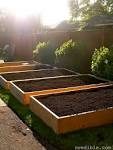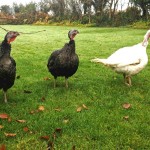Preparation
Thoughts really are now starting to turn to next year’s growing. If you are planning to cover down your beds for the winter (which will keep the worst of the bad weather off them, suppress weeds and prevent the rain from leaching nutrients from the soil), you need to get working on it. It’s also a good time to prepare new ground for spring. Buy yourself a good spade.
Or alternatively try cutting back the grass, then cover the area with about five layers of newspaper and then a layer of compost. Next Spring you should be able to dig straight into this new patch and prepare it for planting. Start investigating seed catalogues for next year.
To Do List
- ‘Earth up’ vegetables that will be buffeted by the winds and storms over the winter such as cabbage, cauliflower and particularly Brussels sprouts.
- Tie Brussels sprouts and sprouting broccoli to canes and apply mulch. Continue to tidy up beds, removing crops, digging in green manures etc.
- Divide up your rhubarb if you want to propagate and cover it with a thick mulch of manure.
- If you grow perennial herbs outside, it’s a good idea to move them to a sheltered spot.
- Continue to weed ground dug over since a crop has been removed – they say “one years seeding is seven years a weeding”!
- Prune apple trees – you are aiming for a goblet-shaped open tree. Prune any crossed and damaged branches, and those that are growing in towards the centre of the tree. The key is to improve circulation of air around the tree. Don’t over prune as this will mean much leafy growth next year and little fruit.
- Mulch raspberries, loganberry and tayberry plants if you haven’t already done so.
- Take cuttings of currant bushes from current season’s wood. Cutting should be 25cm long.
Sowing Seeds And Planting Out
As per last month’s calendar you can sow broad beans outside now for an early crop next spring. It’s important to use over-winter varieties such as ‘Aquadulce’. To avoid broad beans seeds rotting before germination, make small newspaper cups and germinate them indoors first. The polytunnel/greenhouse has its own microclimate – continue to sow carrots, red cabbage, rocket, mixed salad leaves, lambs lettuce, perpetual spinach. Next summer’s garlic does best if it’s planted before Christmas – plant outdoors in well prepared soil in a sunny spot. Some varieties of onion seeds and sets can over-winter and will be ready to harvest in early summer. Again choose a well drained soil, otherwise they will rot. Keep an eye on them for frost heave.
Harvesting – What’s In Season?
Early frosts can kill off tender vegetables but you can continue to harvest perpetual spinach, cabbage, cauliflower, potatoes, swede, parsnips, apples, pears. Start harvesting leeks (very tasty if cut really fine and sautéed in some butter), winter cabbage, kale, artichokes, Brussels sprouts. Time to lift carrots and turnips or at least cover them with a good layer of straw to keep them warm.



